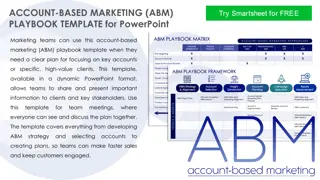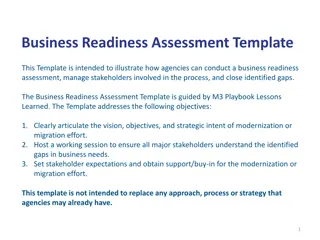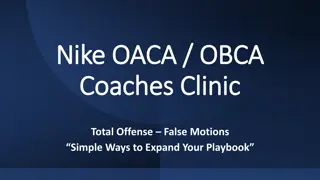
Six Figure Business Playbook
Six Figure Business Playbook
Download Presentation

Please find below an Image/Link to download the presentation.
The content on the website is provided AS IS for your information and personal use only. It may not be sold, licensed, or shared on other websites without obtaining consent from the author. If you encounter any issues during the download, it is possible that the publisher has removed the file from their server.
You are allowed to download the files provided on this website for personal or commercial use, subject to the condition that they are used lawfully. All files are the property of their respective owners.
The content on the website is provided AS IS for your information and personal use only. It may not be sold, licensed, or shared on other websites without obtaining consent from the author.
E N D
Presentation Transcript
SIX-FIGURE Digital-trends.fun
1. Introduction 2.E-commerce Arbitrage 3.Digital Products 4.Dropshipping 5.Affiliate Marketing 6.Consulting Services 7.Subscription Box Service 8.Freelancing 9.Software as a Service (SaaS) 10.Event Planning and Management 11.Real Estate Investing
I N T R O D U C T I O N If you purchase this e-book then, i m assuming you are seeking guidance on business ideas or what business plays will meke you the most money. Well lucky for you, you re in the right spot! Welcome to the realm where creativity meets profitability. At Luxe Digital Boss Babe, we specialize in crafting premium digital items that not only captivate but also generate substantial income. With a proven track record of six-figure success, we are pioneers in the digital marketplace, setting trends and redefining standards. Our passion lies in innovation, and our products reflect this dedication. From meticulously designed graphic assets to intricately coded software solutions, each item in our collection is a masterpiece, meticulously crafted to meet the evolving needs of our diverse clientele. What sets us apart is our commitment to excellence. We don't just create digital items; we curate experiences. Whether you're a budding entrepreneur looking to launch your online store or an established business aiming to enhance your digital presence, we have the tools to propel you towards success. Join the ranks of elite creators and entrepreneurs who have unlocked the power of digital commerce with [Your Name/Brand]. Let us be your partner in prosperity, guiding you towards unparalleled growth and prosperity in the digital landscape.
E - C O M M E R C E A R B I T R A G E What is E-commerce Arbitrage and how can it be profitable? E-commerce arbitrage is a business model where individuals or companies buy products from one online marketplace or retailer at a lower price and then resell them for a profit on another platform or marketplace. This typically involves exploiting price differences between different online marketplaces, taking advantage of fluctuations in supply and demand, or leveraging various discounts, coupons, or promotions. Here's how e-commerce arbitrage can be profitable 1.Price Discrepancies: Different online marketplaces often have different pricing strategies and pricing algorithms. This can lead to products being priced lower on one platform compared to another. By identifying these price discrepancies, arbitrageurs can purchase items at a lower price from one platform and sell them for a higher price on another. 2.Seasonal or Regional Variation: Prices of products can vary based on factors like seasonal demand or regional preferences. E-commerce arbitrageurs can exploit these variations by purchasing products in regions where they are cheaper or during off-peak seasons and then selling them in regions or during seasons where demand and prices are higher. 3.Clearance Sales and Discounts: Retailers frequently offer clearance sales, discounts, or promotions to clear out inventory. Arbitrageurs can take advantage of these opportunities to purchase discounted products in bulk and then resell them at regular prices on other platforms. 4.Dropshipping: In dropshipping, sellers list products for sale without actually holding inventory. When a customer places an order, the seller purchases the product from a third-party supplier and has it shipped directly to the customer. E-commerce arbitrageurs can use dropshipping to leverage price differences and profit margins without the need for inventory storage or upfront investment.
E - C O M M E R C E A R B I T R A G E 5. Online Marketplaces and Platforms: Utilizing various online marketplaces and platforms with different fee structures, shipping options, and customer bases can also contribute to profitability in e-commerce arbitrage. By selecting the most advantageous platforms for buying and selling, arbitrageurs can maximize their profits. However, it's important to note that e-commerce arbitrage can also have challenges and risks, such as competition, fluctuating market conditions, logistical issues, and potential policy violations on certain platforms. Successful arbitrage requires careful research, monitoring of market trends, and effective execution strategies. B R A I N S T O R M I N G . . . . . . . You are a savvy e-commerce entrepreneur looking to capitalize on the lucrative opportunities presented by e-commerce arbitrage. Develop a comprehensive strategy outlining how you will identify profitable product niches, source inventory from various online marketplaces or retailers, and effectively resell products for a significant profit margin on different platforms. Consider factors such as pricing differentials, seasonal variations, clearance sales, and dropshipping options.
D I G I T A L P R O D U C T S What are digital products and how can it be profitable? Digital products are goods or services that are delivered and consumed electronically. They can take various forms, including software, e-books, online courses, digital art, music, videos, apps, templates, and more. The key characteristic of digital products is that they are intangible and can be easily replicated and distributed at low cost. There are several ways digital products can be profitable: 1.Low production costs: Once created, digital products can be replicated and distributed at minimal cost, leading to high-profit margins. There are no costs associated with physical production, storage, or shipping. 2.Scalability: Digital products can be scaled infinitely without incurring significant additional costs. Whether you sell one copy or a thousand, the production and distribution process remains the same. 3.Global reach: The internet enables digital products to reach a global audience. With the right marketing strategies, you can sell your digital products to customers anywhere in the world, expanding your market and revenue potential. 4.Automation: Many aspects of selling digital products can be automated, including payment processing, delivery, and customer support. This allows you to generate passive income with minimal ongoing effort once the initial setup is complete. 5.Diverse monetization options: There are various ways to monetize digital products, such as one-time purchases, subscriptions, licensing, affiliate marketing, and advertising. You can choose the monetization model that best fits your product and target audience.
D I G I T A L P R O D U C T S 6. Flexibility: Digital products offer flexibility in terms of pricing, packaging, and distribution. You can experiment with different pricing strategies, bundle products together, and offer discounts or promotions to attract customers and maximize revenue. To make digital products profitable, it's essential to understand your target market, create high-quality products that address their needs or interests, and invest in effective marketing and distribution channels to reach potential customers. Additionally, maintaining good customer relationships and continually updating and improving your products can help sustain long-term profitability. H E R E S A C O U P L E E X A M P L E S O F D I G I T A L P R O D U C T S T O S E L L Membership Sites or Subscription Services: Offer access to a library of exclusive content such as articles, videos, or tutorials. Create a monthly subscription box with digital downloads, discounts, or exclusive offers. Develop a community forum or discussion platform with premium membership features. Offer ongoing access to software updates, new content, or support for a recurring fee. Online Courses: Offer a course on mastering a particular software tool or programming language. Develop a course on personal finance management or investment strategies. Create a photography course covering various techniques or genres. Design a fitness or yoga program tailored to different skill levels.
D R O P S H I P P I N G 4 . What is dropshipping and how can it be profitable? Dropshipping is a retail fulfillment method where a store doesn't keep the products it sells in stock. Instead, when a store sells a product using the dropshipping model, it purchases the item from a third party and has it shipped directly to the customer. As a result, the seller doesn't have to handle the product directly, which can save time, money, and hassle associated with inventory management and shipping. Here's how dropshipping typically works 1. The customer places an order on the retailer's online store. 2.The retailer forwards the order and customer details to the dropshipping supplier. 3.The dropshipping supplier packages and ships the product directly to the customer. 4.The retailer pays the wholesale price to the dropshipping supplier, keeping the difference between the wholesale and retail prices as profit. Dropshipping can be profitable for several reasons Low upfront investment: Since you don't need to purchase inventory upfront, the initial investment required to start a dropshipping business is relatively low compared to traditional retail models. Reduced overhead costs: Dropshipping eliminates the need for warehousing, inventory management, and fulfillment staff, reducing overhead costs significantly.
D R O P S H I P P I N G Wider product selection: With dropshipping, you can offer a wide range of products without having to stock them yourself. This allows you to cater to different customer preferences and test new products with minimal risk. Location independence: Since you don't need to manage inventory or handle shipping, you can run a dropshipping business from anywhere with an internet connection, providing flexibility and freedom. Scalability: Dropshipping allows you to scale your business quickly since you don't have to worry about managing inventory levels or fulfillment logistics. As your business grows, you can easily add new products or expand into new markets. However, it's essential to note that dropshipping also comes with its challenges, such as intense competition, lower profit margins compared to traditional retail, reliance on suppliers for inventory availability and shipping times, and potential issues with product quality and customer service. Success in dropshipping often requires careful product selection, effective marketing strategies, excellent customer service, and continuous optimization of your business operations. Niche Selection: Explore various niche markets and identify potential products that cater to specific interests or needs. For example: "Research and identify niche markets with high demand but low competition for dropshipping." "Brainstorm product ideas for niche markets such as eco-friendly home goods, pet accessories, or outdoor camping gear."
A F F I L I A T E M A R K E T I N G What is affiliated marketing and why is it profitable? Affiliate marketing is a performance-based marketing strategy where a business rewards one or more affiliates for each visitor or customer brought by the affiliate's marketing efforts. In simpler terms, it's a way for businesses to generate sales or leads by partnering with individuals or other businesses (affiliates) who promote their products or services in exchange for a commission on successful sales. Here's how it typically works 1.Affiliate Signs Up: An individual or business signs up for an affiliate program offered by a company. 2.Promotion: The affiliate promotes the products or services of the company through various channels such as websites, blogs, social media, email newsletters, etc. They may use unique tracking links or codes provided by the company to track their referrals. 3.Conversion: When a customer referred by the affiliate makes a purchase or completes a desired action (like signing up for a service or filling out a form), the affiliate earns a commission. 4.Commission Payment: The company pays the affiliate the agreed- upon commission for each successful referral.
A F F I L I A T E M A R K E T I N G Affiliate marketing can be profitable for several reasons 1.Cost-Effective: For businesses, affiliate marketing is a performance- based model, meaning they only pay for actual sales or leads generated. This makes it a cost-effective marketing strategy compared to traditional advertising where they pay upfront without any guarantee of results. 2.Broader Reach: Affiliates can reach a broader audience through their various marketing channels, including social media, blogs, websites, and email lists. This can help businesses tap into new markets and customer segments they may not have been able to reach on their own. 3.Low Risk: Since businesses only pay for actual results, there's minimal risk involved. If an affiliate's efforts don't generate sales or leads, the business doesn't incur any costs. 4.Scalability: Affiliate marketing can easily scale as businesses can recruit multiple affiliates to promote their products or services. As the affiliate network grows, so does the potential for increased sales and revenue. 5.Increased Brand Visibility: Having affiliates promote their products or services can help businesses increase brand visibility and credibility. Positive reviews and recommendations from affiliates can also help build trust among potential customers. Overall, affiliate marketing offers a win-win situation for both businesses and affiliates. Businesses benefit from increased sales and brand exposure, while affiliates can earn passive income by promoting products or services they believe in.
C O N S U L T I N G S E R V I C E S What is consulting services and why is it profitable? Consulting services involve providing expert advice, guidance, and solutions to individuals or organizations seeking assistance in various areas such as management, strategy, technology, finance, marketing, and more. Consultants typically possess specialized knowledge, skills, and experience in their respective fields, which they leverage to help clients solve specific problems, improve performance, or achieve their goals. Consulting services can be highly profitable for several reasons 1.Specialized Expertise: Consultants often have deep expertise and experience in specific domains, allowing them to offer valuable insights and solutions that may not be readily available within the client's organization. This specialized knowledge commands premium fees. 2.High Demand: As businesses face increasingly complex challenges and rapid technological advancements, the demand for specialized expertise and outside perspectives has grown. Consulting services can help organizations navigate these challenges more effectively. 3.Cost Savings: Hiring consultants can be more cost-effective than maintaining in-house expertise, particularly for short-term projects or specialized tasks. It allows organizations to access specialized skills without the long-term commitment of hiring full-time employees.
C O N S U L T I N G S E R V I C E S 1.Objective Perspective: Consultants bring an outsider's perspective, which can be invaluable in identifying blind spots, uncovering inefficiencies, and proposing innovative solutions. This objectivity helps clients make more informed decisions and drive organizational change. 2.Flexibility and Scalability: Consulting services offer flexibility in terms of project scope, duration, and resource allocation. Consultants can scale their services up or down based on the client's needs, providing a tailored approach that maximizes value. 3.Reputation and Networks: Established consulting firms often have strong reputations and extensive networks, which can attract clients and open doors to new opportunities. A reputable consulting brand can command higher fees and attract top talent. 4.Value Creation: Ultimately, consulting services aim to deliver tangible value to clients by solving problems, optimizing processes, driving growth, or improving performance. When consultants effectively deliver on their promises, clients are willing to pay premium fees for the results achieved. Overall, the profitability of consulting services stems from the combination of specialized expertise, high demand, cost-effectiveness, flexibility, and the ability to deliver tangible value to clients.
S U B S C R I P T I O N B O X S E R V I C E What is Subscription Box Service and why is it profitable? A subscription box service is a business model where customers pay a recurring fee, typically monthly, to receive a box of curated products delivered to their doorstep. These boxes often contain items related to a specific theme, such as beauty products, snacks, books, or clothing, and are usually a surprise for the customer each month. There are several reasons why subscription box services can be profitable 1.Predictable Revenue: Subscription models provide a steady stream of income since customers are billed on a recurring basis. This predictability allows companies to better plan inventory, production, and marketing strategies. 2.Customer Retention: Subscribers tend to stick with the service for longer periods, especially if they're satisfied with the products they receive. This reduces customer churn and acquisition costs, as it's generally more expensive to acquire new customers than to retain existing ones. 3.Economies of Scale: Subscription box services often negotiate bulk discounts with suppliers since they buy products in large quantities to fulfill their monthly boxes. This allows them to obtain products at a lower cost, increasing profit margins.
S U B S C R I P T I O N B O X S E R V I C E 1.Data Insights: Subscription businesses gather valuable data on customer preferences and behaviors through their subscription platform. This data can be used to personalize offerings, improve product selection, and enhance customer experience, leading to higher customer satisfaction and retention. 2.Brand Loyalty and Community Building: Subscription boxes create a sense of anticipation and excitement among customers who look forward to receiving their monthly surprises. This builds brand loyalty and can foster a sense of community among subscribers who share their experiences and recommendations. 3.Cross-selling and Upselling Opportunities: Subscription box companies can cross-sell or upsell additional products or services to their subscriber base, increasing their average revenue per user (ARPU). For example, they may offer exclusive or premium versions of their boxes, add-on products, or companion services. Overall, the combination of recurring revenue, customer retention, economies of scale, data-driven insights, brand loyalty, and upselling opportunities makes subscription box services a profitable business model when executed effectively.
F R E E L A N C I N G What is freelancing and how is it profitable? Freelancing is a work arrangement where individuals offer their skills and services to clients on a project basis, without being bound to a long-term contract with any single employer. Freelancers typically work remotely and may provide services in various fields such as writing, graphic design, programming, consulting, marketing, and more. Freelancing can be profitable for several reasons 1.Flexibility: Freelancers have the freedom to choose their own working hours, projects, and clients. This flexibility allows them to balance work with personal commitments and pursue multiple income streams. 2.Higher Rates: Freelancers often have the potential to earn higher rates compared to traditional employment, especially if they have specialized skills or expertise that are in high demand. 3.Lower Overhead Costs: Freelancers typically work from home or shared workspaces, which reduces overhead costs associated with maintaining a physical office. This means they can keep more of their earnings as profit.
F R E E L A N C I N G 1.Access to Global Market: The internet has made it easier for freelancers to connect with clients from around the world. This access to a global market increases the potential for finding higher-paying projects. 2.Diverse Client Base: Freelancers can work with a diverse range of clients across different industries, allowing them to gain experience and build a portfolio that can attract more lucrative opportunities. 3.Scalability: Freelancers can scale their businesses by increasing their rates, expanding their service offerings, or hiring subcontractors to handle additional work. This scalability allows them to grow their income over time. However, it's important to note that freelancing also comes with challenges, such as inconsistent income, the need for self-discipline and time management, and the responsibility of managing all aspects of the business, including marketing, invoicing, and client communication. Success in freelancing often requires a combination of skill, perseverance, networking, and adaptability.
S O F T W A R E A S A S E R V I C E ( S A A S ) What is Software as a Service (SaaS) and how is it profitable? Software as a Service (SaaS) is a cloud-based software delivery model where software is hosted on cloud servers and accessed via the internet. In this model, users typically pay a subscription fee to access and use the software, rather than purchasing a license for a specific version of the software. SaaS providers handle maintenance, updates, security, and infrastructure, relieving users of these responsibilities. Here's how SaaS is profitable 1.Recurring Revenue: SaaS operates on a subscription-based model, which generates recurring revenue for the provider. Instead of a one- time purchase, customers pay a monthly or annual fee for access to the software. This predictable revenue stream provides stability and allows for better long-term planning. 2.Scalability: SaaS can scale easily to accommodate growing user bases without significant upfront costs. As more customers subscribe to the service, revenue increases without a proportional increase in infrastructure or operational costs. 3.Reduced Upfront Costs for Customers: Since SaaS typically doesn't require upfront investments in hardware or software licenses, it lowers the barrier to entry for customers. They can start using the software immediately with minimal setup costs.
S O F T W A R E A S A S E R V I C E ( S A A S ) 1.Lower Maintenance Costs: SaaS providers handle maintenance, updates, and infrastructure management, reducing the burden on customers. This lowers the total cost of ownership for customers compared to traditional software, where they would need to manage updates and maintenance themselves. 2.Global Reach: SaaS is accessible via the internet, allowing providers to reach customers globally without the need for physical distribution channels. This expands the potential market and revenue opportunities. 3.Data-driven Insights: SaaS platforms often collect data on user behavior, usage patterns, and other metrics. This data can be analyzed to gain insights into customer preferences, improve the product, and inform marketing strategies. 4.Add-on Services and Upgrades: SaaS providers can offer additional services, premium features, or upgrades to customers for an additional fee. This creates opportunities for upselling and increasing revenue from existing customers. Overall, the combination of recurring revenue, scalability, reduced upfront costs for customers, and additional revenue streams makes SaaS a profitable business model for software providers.
E V E N T P L A N N I N G A N D M A N A G E M E N T What is Event Planning and Management and why is it profitable? Event planning and management involves the organization and execution of events such as conferences, weddings, parties, corporate gatherings, festivals, and more. It encompasses various tasks such as budgeting, scheduling, venue selection, vendor coordination, marketing, and on-site management to ensure that events run smoothly and successfully. There are several reasons why event planning and management can be profitable 1.Demand: There is a consistent demand for events across various industries and sectors. Individuals, businesses, organizations, and governments frequently host events for various purposes such as networking, promotion, celebration, education, and entertainment. 2.Specialized expertise: Planning and managing events require specialized skills and knowledge in areas such as logistics, marketing, design, and customer service. Event planners and managers offer their expertise to clients who may lack the time, resources, or know-how to organize successful events on their own. 3.Customization: Events often need to be tailored to meet the specific objectives, preferences, and budget of the client. This customization allows event planners and managers to offer personalized services, which can command higher fees.
E V E N T P L A N N I N G A N D M A N A G E M E N T 1.Vendor relationships: Experienced event planners and managers typically have established relationships with vendors such as venues, caterers, decorators, and entertainers. These relationships can result in cost savings for clients and additional revenue streams for the event planners through commissions or referral fees. 2.Scalability: Event planning and management businesses can scale their operations by taking on multiple projects simultaneously or expanding their service offerings to include additional types of events or supplementary services such as event marketing or post-event evaluation. 3.Repeat business and referrals: Satisfied clients are likely to return for future events and recommend the services of their event planner to others. Building a reputation for delivering high-quality events can lead to a steady stream of repeat business and referrals, which contributes to long-term profitability. Overall, event planning and management can be profitable due to the ongoing demand for events, the specialized expertise required, the ability to customize services, strong vendor relationships, scalability, and the potential for repeat business and referrals.
R E A L E S T A T E I N V E S T I N G What is real estate investing and how is it profitable? Real estate investing involves purchasing, owning, managing, renting, or selling real estate properties for the purpose of generating profit. There are several ways in which real estate investing can be profitable 1.Rental Income: One of the most common ways to profit from real estate investing is through rental income. Investors purchase properties and rent them out to tenants, generating a steady stream of rental income. 2.Appreciation: Over time, real estate properties typically increase in value due to factors such as inflation, supply and demand dynamics, and improvements to the property or surrounding area. Investors can profit from appreciation by selling the property at a higher price than they paid for it. 3.Equity Build-Up: When investors use leverage, such as a mortgage, to purchase a property, they build equity in the property over time as they pay down the loan balance. This equity can be accessed through refinancing or selling the property.
R E A L E S T A T E I N V E S T I N G 1.Tax Benefits: Real estate investors can take advantage of various tax benefits, including deductions for mortgage interest, property taxes, depreciation, and expenses related to property maintenance and management. 2.Cash Flow: Positive cash flow occurs when the rental income from a property exceeds the expenses associated with owning and managing it. Cash flow can provide investors with ongoing income and financial stability. 3.Diversification: Real estate investing can help diversify an investment portfolio, reducing overall risk. Real estate often has a low correlation with other asset classes, such as stocks and bonds, meaning that it may perform differently under various market conditions. 4.Control: Unlike some other types of investments, such as stocks or mutual funds, real estate investors have more control over their investments. They can make decisions regarding property management, renovations, and other factors that can directly impact profitability. Overall, real estate investing can be a profitable venture for those who are willing to research properties, understand market trends, manage properties effectively, and make informed investment decisions. However, like any investment, it also carries risks, such as fluctuations in property values, unexpected expenses, and changes in market conditions.






















